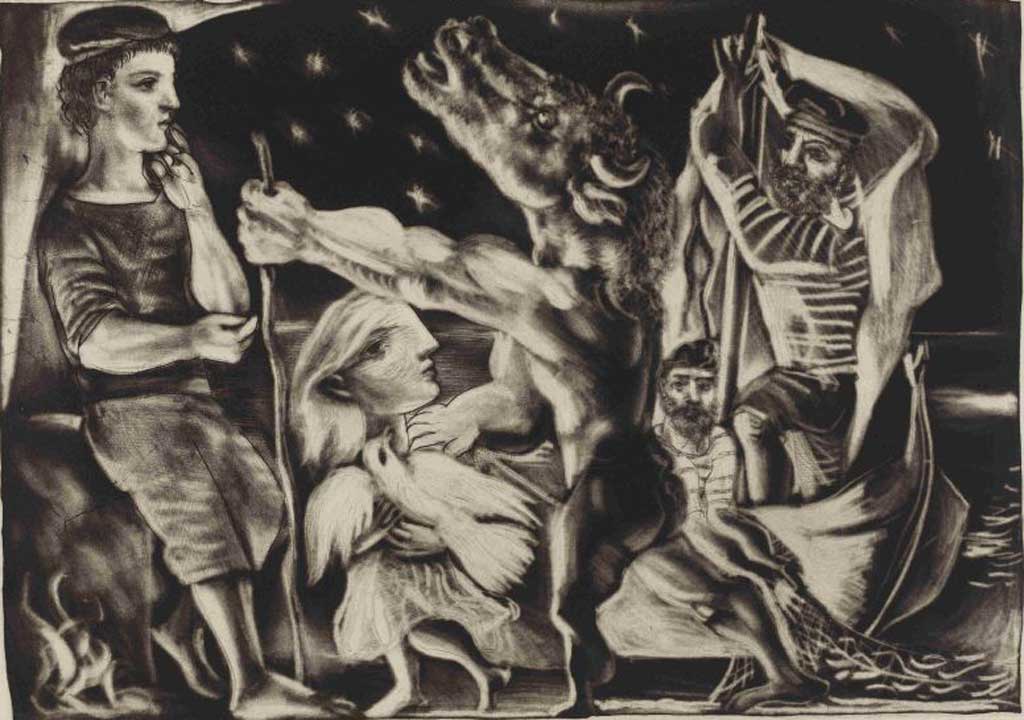Great Works: Blind Minotaur Led by a Little Girl in the Night, 1934, by Pablo Picasso
British Museum, London

Dealing with Picasso is a little like wrestling the phantom presence of some unkillable Minotaur to the ground. Even now, almost 40 years after his death, we are still discovering him, judging him, assessing his legacy. Matters are complicated by the fact that almost everything Picasso ever made or perhaps even breathed on, no matter how ridiculously slight, turns to gold in the auction room.
Much was not gold, of course. It was dross – as it would be with any workaholic artist who produced in excess of 10,000 paintings during his lifetime. (By comparison, 34 are attributed to Vermeer and fewer than 20 to Leonardo). The Picasso industry works judiciously, tirelessly, to sustain the value of the brand in order to maximise the reputation – and therefore the income. So how do we choose something incontrovertibly magnificent? Frankly, we could go anywhere, to any period. A great Picasso happens on the wing. His fertility waxed and waxed, constantly. It was also ceaseless.
Take this etching, for example, numbered 97th from a hundred produced for the dealer Ambroise Vollard during the 1930s over a period of about seven years, and known collectively as the Vollard Suite. You can see it on display in the Prints and Drawings Room of the British Museum until 2 September. To survey this suite, one by one, is to recognise the astonishing versatility and the imaginative reach of this man, his ability to play a bewildering number of variations upon a number of time-honoured themes: the artist in his studio; the artist and his muse; the magical, Pygmalion-like character of the made thing. Unfortunately, you cannot do with an etching what you might do with an oil painting – paint and scrape off, paint and scrape off. Sureness of line is of the essence.
The suite is grounded in classical mythology, as was so much work by Picasso and others after the Great War. This tendency is often regarded as safe and revanchist, as if the war had put the derring-do of modernity to flight forever; as if myth represented some comfortable retreat into the past. Nonsense. A great artist can make anything anew. The great figures of classical mythology were alive for Picasso from first to last. Here we see the raging Minotaur, half man, half bull, of Cretan extraction. It is raging no more. In fact, you could say that it is howling at the moon. It has lost its mighty potency. Now blind and helpless, it is being led along by a little girl, who also clutches a dove. This child is usually taken to be a likeness of Marie-Thérèse, the 17-year-old girl Picasso had met in the late 1920s, and who supplanted his wife in his affections. She in her turn was to be supplanted by Dora Maar.
Now what exactly does this Minotaur mean – in addition, that is, to what we can read about it in, say, Robert Graves's guide to Greek myths? The Minotaur is, for one, a symbol of Spain – we can see confirmation of that as we look through other etchings in the series. The Minotaur is the bull in the ring. Picasso, like Goya before him, is celebrating the power, the muscularity, the virility of the bull, which is a mighty symbol of nationhood. But in the 1930s, and increasingly so, Spain's identity as a nation was under threat. So you can say that this image seems to augur the onset of new political unrest in Europe, and even to anticipate the plight and the suffering of his homeland, soon to be torn apart by civil war within and invasion from without – which will culminate of course, in Guernica. But the Minotaur is Picasso too, that raging sexual beast who is being led along – o, the foolishness of passion! – by a sweet girl. The beast, that mighty seducer, rages near uncontrollably in other etchings of the series, looming over the helpless female form.
So nationalism and autobiography feed their meanings into the mix. A third element takes in Surrealism. To Surrealists, the Minotaur represented the unbridled, unstoppable force of the Unconscious. Why blind though? The Minotaur was never blind in classical mythology. This is a detail of Picasso's invention. He – like many other artists – feared blindness. It had haunted paintings of his Blue Period. The blinded Minotaur is the fear that the power to respond to the near unstoppable force of the creative impulse will suddenly leave him.
It was not to be. Hence our headache.
About the artist: Pablo Picasso (1881-1973)
Pablo Picasso (1881-1973) was born in Malaga, and displayed prodigious talents as a painter from his earliest years. Ceaselessly capable of re-invention, he tore up the rule book of representational figurative painting with Les Demoiselles d'Avignon (1907), which introduced a kind of jarringly savage primitivism into female portraiture, and he continued to experiment, in painting, sculpture, etching and ceramic, throughout his long working life. He was a man who spoke little about his work. His achievement lay in what he did.
Join our commenting forum
Join thought-provoking conversations, follow other Independent readers and see their replies
Comments
Bookmark popover
Removed from bookmarks